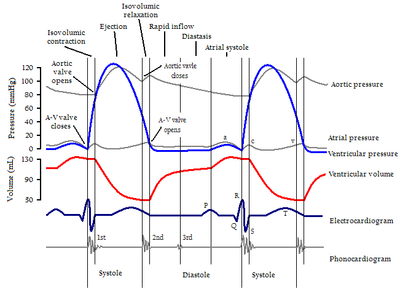- Diastole
-
 Heart during ventricular diastole.
Heart during ventricular diastole.
Diastole (
 /daɪˈæstəliː/) is the period of time when the heart fills with blood after systole (contraction). Ventricular diastole is the period during which the ventricles are relaxing, while atrial diastole is the period during which the atria are relaxing. The term diastole originates from the Greek word διαστολη, meaning dilation.[1]
/daɪˈæstəliː/) is the period of time when the heart fills with blood after systole (contraction). Ventricular diastole is the period during which the ventricles are relaxing, while atrial diastole is the period during which the atria are relaxing. The term diastole originates from the Greek word διαστολη, meaning dilation.[1]Contents
Inside the heart
Wiggers diagram, showing various events during diastole (duration marked at bottom).
During ventricular diastole, the pressure in the (left and right) ventricles drops from the peak that it reaches in systole. When the pressure in the left ventricle drops to below the pressure in the left atrium, the mitral valve opens, causing accumulated blood from the atrium to flow into the ventricle. An easy way to think about this, though untrue, is that diastole is a sump that induces suction of blood into the heart to prepare for the next pump of systole. The heart is actually filled by the momentum of the blood flowing from the previous systolic cycle, with the "atrial kick" serving as a way to "hoist" the ventricular myocardium over the mass of blood contained within the chamber just prior to systole.
The ventricular filling velocity or flow into the ventricles have two main components; First an early (E) diastolic one caused by accumulation of blood in the atria during previous systole, and second, a late one created by atrial contraction (A). The E/A ratio can be used as a diagnostic measure, since it is reduced in diastolic dysfunction.[2]
Inside the arteries
The adjective "diastolic" is used to refer to filling of the heart with blood between muscle contractions. It is used to describe the opposite portion of the cardiac cycle related to contraction. More typically it is used as one component of measurement of blood pressure. "Diastolic pressure" refers to the lowest pressure within the arterial blood stream occurring during each heart beat. The other component of blood pressure is systolic pressure, which refers to the highest arterial pressure during each heart beat.
When blood pressure is stated for medical purposes, it is usually summarized as a "ratio" of systolic to diastolic pressure; for example: 120/80 mmHg. However, this is not a true ratio: it cannot be reduced into lower terms.
See also
References
- ^ Diastole. Merriam-Webster Online Dictionary. 24 August 2008.
- ^ [1] Abdul Latif Mohamed, Jun Yong, Jamil Masiyati, Lee Lim, Sze Chec Tee. The Prevalence Of Diastolic Dysfunction In Patients With Hypertension Referred For Echocardiographic Assessment of Left Ventricular Function. Malaysian Journal of Medical Sciences, Vol. 11, No. 1, January 2004, pp. 66-74
External links
Categories:
Wikimedia Foundation. 2010.

